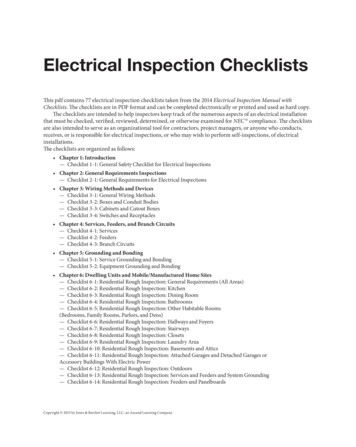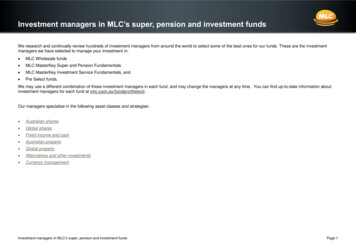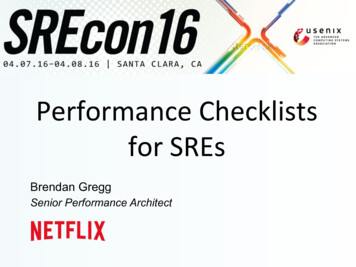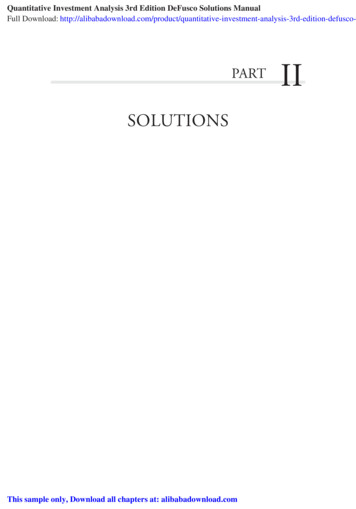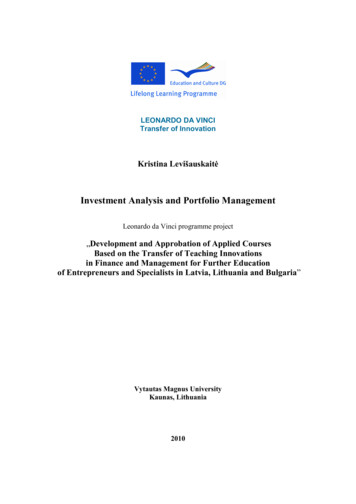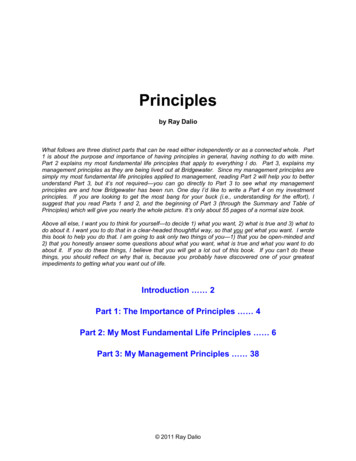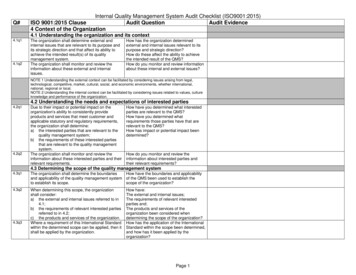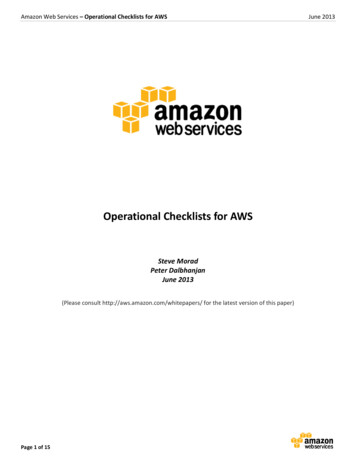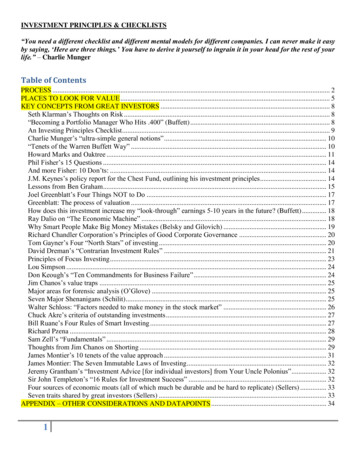
Transcription
INVESTMENT PRINCIPLES & CHECKLISTS“You need a different checklist and different mental models for different companies. I can never make it easyby saying, ‘Here are three things.’ You have to derive it yourself to ingrain it in your head for the rest of yourlife.” – Charlie MungerTable of ContentsPROCESS . 2PLACES TO LOOK FOR VALUE . 5KEY CONCEPTS FROM GREAT INVESTORS . 8Seth Klarman’s Thoughts on Risk . 8“Becoming a Portfolio Manager Who Hits .400” (Buffett) . 8An Investing Principles Checklist . 9Charlie Munger’s “ultra-simple general notions” . 10“Tenets of the Warren Buffett Way” . 10Howard Marks and Oaktree . 11Phil Fisher’s 15 Questions . 14And more Fisher: 10 Don’ts: . 14J.M. Keynes’s policy report for the Chest Fund, outlining his investment principles . 14Lessons from Ben Graham. 15Joel Greenblatt’s Four Things NOT to Do . 17Greenblatt: The process of valuation . 17How does this investment increase my “look-through” earnings 5-10 years in the future? (Buffett) . 18Ray Dalio on “The Economic Machine” . 18Why Smart People Make Big Money Mistakes (Belsky and Gilovich) . 19Richard Chandler Corporation’s Principles of Good Corporate Governance . 20Tom Gayner’s Four “North Stars” of investing . 20David Dreman’s “Contrarian Investment Rules” . 21Principles of Focus Investing . 23Lou Simpson . 24Don Keough’s “Ten Commandments for Business Failure” . 24Jim Chanos’s value traps . 25Major areas for forensic analysis (O’Glove) . 25Seven Major Shenanigans (Schilit) . 25Walter Schloss: “Factors needed to make money in the stock market” . 26Chuck Akre’s criteria of outstanding investments . 27Bill Ruane’s Four Rules of Smart Investing . 27Richard Pzena . 28Sam Zell’s “Fundamentals” . 29Thoughts from Jim Chanos on Shorting . 29James Montier’s 10 tenets of the value approach . 31James Montier: The Seven Immutable Laws of Investing. 32Jeremy Grantham’s “Investment Advice [for individual investors] from Your Uncle Polonius” . 32Sir John Templeton’s “16 Rules for Investment Success” . 32Four sources of economic moats (all of which much be durable and be hard to replicate) (Sellers) . 33Seven traits shared by great investors (Sellers) . 33APPENDIX – OTHER CONSIDERATIONS AND DATAPOINTS . 341
Good checklists are precise, efficient, easy to use even under difficult conditions, do not try to spell outeverything, and provide reminders of only the most critical and important steps; the power of checklistsis limitedo Bad checklists are vague, imprecise, too long, hard to use, impractical, and try to spell out everysingle stepDo-confirm checklist: perform jobs/tasks from memory and experience, but then stop, run the checklistand confirm that everything was done correctlyRead-do checklist: carry out tasks as they are checked off – more like a recipePROCESSFocus on original source documents, working from in to out SEC fillingso Read 10-Qs, 10-Ks, proxies and other filings in reverse chronological orderPress releases and earnings calls/transcriptsOther public informationo Court documents, real estate records, etc.Industry publicationsThird-party analystso Sell-side research only as a consensus-checking exerciseResearch the company’s competitors with the same processo Research and speak to competitors, (former) employees, and people in the supply chainEstimate valuation before looking at market valuationo Valuation – What would a rational, long-term, private buyer would pay in cash today for theentire business? Asset value Earning power if EP NAV, then franchise value Growth valueRequirementso Large, well understood margin of safetyo Reinvestment opportunities for capital in the businesso Quality, ownership stake, and shareholder-orientation of managemento Ability to bear pain, both the company’s and my ownMunger’s “Four Filters” Understand the business Sustainable competitive advantages (aka, favorable long-term economics) Able and trustworthy management Price that affords a margin of safety (aka, a sensible purchase price)2
Pause Points in the Process Always think in terms of Process Patience How big is the margin of safety? How reliable is it? Why?Pause #1 Are the business and its securities able to be understood and valued?o Avoid loss byPause #2 Go back through all financial disclosure looking for information and context missed the first timeo Patterns/trends Level and quality of disclosureo Specifics (see next section)Pause #3 – final checks What can go wrong? Do a “pre-mortem”How can capital be permanently impaired by this investment?What are the probabilities? Are the odds heavily in my favor?What is the time horizon?How attractive is the opportunity? Namely, how attractive is compared to my best currentinvestment?Munger’s “two-track analysis” First, lay out and deeply understand the rational factors that govern the situation under considerationSecond, focus attention on psychological missteps – either your own or those of other investors“The Most Important Things”o Margin of safetyo Balance sheet Capital structure and liquidity Asset valueo Cash flow Realistic and reliable owner’s earnings (especially a few years from now) Can cash be reinvested at attractive compound rates? How has management allocated capital?Initial ideas to consider in the process1. Separate the business from the balance sheet How is the business capitalized? Is it sustainable? Is it relatively efficient/optimal? What are the assets worth? Liquidation value and reproduction value Are there any “hidden” assets or liabilities?o Excess cash, real estate, LIFO, etc.o Pension, legal liability, litigation, operational malfeasance, funding/liquidity puts, etc.2. Separate the business from the cash flows3
3.4.5.6.7.What are the cash flows saying, regardless of the broader business stereotypes/assumptions?How much cash can be taken out of the business every year? Owner’s earning (net income plus DAminus capex) normalized and over time Earnings yield (EBIT/TEV) and ROIC (EBIT/(WC fixed assets)) What are the capex requirements? With regard to inflation? Depreciation?What is the business’s competitive situation? How good is management? What could kill the business? What disrupts the underlying fundamentals? Competition/moat Cost structure What are incremental margins? How attractive is the compounding opportunity? Is capital being allocated properly? Investing in the business vs. returning capital to shareholders Are the company’s end markets stable/shrinking/growing? Susceptible to rapid (technological)change?Other considerations Market perceptions Quality of management and alignment of interests Is this opportunity worth a punch on our punch card?Psychological factors Think in terms of the “psychology of misjudgment” and common biases (see below)Where are we in the cycle? Where are we in the economic cycle? Where are we in the cycle for risk assets? Where are we in the industry cycle applicable to this company?Portfolio composition Target 15-25 individual (i.e., diversified or uncorrelated) investments1 Size constraints Portfolio liquidity Ability to withstand painFinal Checks Who’s selling? Why?o Who’s wrong and making a mistake here, the buyer or the seller? Investing as a game of mistakes; avoid making mistakes while seeking to identifymistakes made by others Pre-mortemo Consider a view, looking back from 1/3/5 years in the future, that considers all of the ways inwhich this idea failed horribly; seek outside input More vulnerable to Type I or Type II errors?o Type I error, also known as an "error of the first kind" or a "false positive": the error of rejectinga null hypothesis when it is actually true. It occurs when observing a difference when in truththere is none, thus indicating a test of poor specificity. An example of this would be if a test1Greenblatt from You Can Be a Stock Market Genius:oOwning two stocks eliminates 46% of nonmarket risk of just owning one stockoFour stocks eliminates 72% of the riskoEight stocks eliminates 81% of the risko16 stocks eliminates 93% of the risko32 stocks eliminates 96% of the risko500 stocks eliminates 99% of the risk4
shows that a woman is pregnant when in reality she is not. Type I error can be viewed as theerror of excessive credulity; it is the notion of “seeing” something that is not really there.o Type II error, also known as an "error of the second kind", or a "false negative": the error offailing to reject a null hypothesis when it is in fact not true. In other words, this is the error offailing to observe a difference when in truth there is one, thus indicating a test of poor sensitivity.An example of this would be if a test shows that a woman is not pregnant, when in reality, she is.Type II error can be viewed as the error of excessive skepticism; it is failing to “see” somethingthat actually exists.Feynman algorithm -- Simplify the problem down to an “essential puzzle.” Ask very basic questions:What is the simplest example? How can you tell if the answer is right? Ask questions until the problemis reduced to some essential puzzle that will be able to be solved.o Continually master new techniques and then apply them to your library of unsolved puzzles tosee if they help.PLACES TO LOOK FOR VALUEConditions and criteria to consider in the search for mistakes and inefficiencies Klarman – Where to Find Investment OpportunitiesSpin-offsForced selling by index fundsForced selling by institutions (e.g., big mutual funds selling “tainted” names)Disaster de jour (e.g., accounting fraud, earnings disappointment, etc; adversity and uncertaintycreate opportunity)Graham-and-Dodd deep value (e.g., discount to break-up value, P/CF 10x)Catalyst (e.g., tender, Dutch auction, other special situations)Real estateForced selling Downgrades, index additions/removals, bankruptcies, margin calls, liquidations, spinoffs Greenblatt on spin-offs: Are insiders buying? Are institutional investors selling without regard to the investment merits?NNWC (Graham): [market cap ((cash STI 75-90% A/R 50-75% Inventories) minus totalliabilities)] Add fixed assets (at 1-50% of carrying value) to approximate liquidation valueand/orNCAV [market cap 2/3 (current assets minus total liabilities)]Negative Enterprise Value [EV market cap plus total debt minus excess cash] where [excess cash total cash – MAX(0, current liabilities minus current assets)]CROIC [free cash flow / invested capital] where [invested capital is net worth plus long-term debt]Earnings yieldFCF yieldEV / FCFROIC, ROE5
ROIC Operating Income / (Total Assets – (Intangibles Cash)) ROE in light of ROIC and assessment of the appropriate capital structureBuffett’s “owner earnings”: net income plus DDA plus other non-cash charges less averagemaintenance capex (including additional working capital, if necessary)2Buffett’s “want ad” Large purchases Demonstrated consistent earnings power (future projections are of little interest to us, nor are“turn-around” situations) Businesses earnings good returns on equity while employing little or no debt Management in place (we can’t supply it) Simple businesses (if there’s lots of technology, we won’t understand it) An offering price (we don’t want to waste our time or that of the seller by talking, evenpreliminarily, about a transaction when price is unknown)Buffett looks to add whole (non-insurance) companies to Berkshire’s portfolio at 9-10x EBTGraham Checklist An earnings-to-price yield at least twice the AAA bond rate P/E ratio less than 40% of the highest P/E ratio the stock had over the past 5 years Dividend yield of at least 2/3 the AAA bond yield Stock price below 2/3 of tangible book value per share Stock price below 2/3 of Net Current Asset Value (NCAV) Total debt less than book value Current ratio greater than 2 Total debt less than two times Net Current Asset Value (NCAV) Earnings growth of prior 10 years 7% annual compound rate Stability of growth of earnings: no more than two year/year declines of 5% over prior 10 yearsGraham Formula [ Value (EPS * (8.5 2g) *4.4) / Y] where EPS is ttm EPS, 8.5 is P/E of a stockwith zero growth (must be adjusted), g is the growth rate expected for next 7-10 years, and Y is theAAA corporate bond rate Implies: G (P/2 – 8.5) / 2 where P is price PCO adjustments: V* { E * (1.5g 7.5) * 5.0 } / Y, where E is adj. EPS; g is expected growthrate over 10 years; Y is long-term, top quality corporate bond yield; 7.5 is the targeted P/E for nogrowthGraham’s “fundamental-agnostic” Screen [a basket of 30 stocks that all have trailing earnings yield 2x AAA bond yield and equity / assets ratio 50%; sell a stock upon the earlier of a 50% gain or 2-3years]Graham-and-Dodd P/E [price divided by 10-year-average earnings)Magic Formula (Greenblatt) Earnings yield (EBIT/TEV) ROIC (EBIT/Invested Capital)2“These represent (a) reported earnings plus (b) depreciation, depletion, amortization, and certain other non-cash and (4) less (c) theaverage annual amount of capitalized expenditures for plant and equipment, etc. that the business requires to fully maintain its longterm competitive position and its unit volume. (If the business requires additional working capital to maintain its competitive positionand unit volume, the increment also should be included in (c) . However, businesses following the LIFO inventory method usually donot require additional working capital if unit volume does not change.) Our owner-earnings equation does not yield the deceptivelyprecise figures provided by GAAP, since (c) must be a guess - and one sometimes very difficult to make. Despite this problem, weconsider the owner earnings figure, not the GAAP figure, to be the relevant item for valuation purposes - both for investors in buyingstocks and for managers in buying entire businesses. We agree with Keynes's observation: ‘I would rather be vaguely right thanprecisely wrong.’”6
Greenblatt – Look for best combinations of: Cheap: “A lot of earnings for the price” – high LTM EBIT / TEV (where TEV is mkt cap pfd minority interest net interest bearing debt) Good: “return on capital” – high return on tangible capital [ LTM EBIT / (working capital net fixed assets) ] To approximate the magic formula screen (which excludes utilities, financials, and foreign cos): use ROA instead of ROIC; set ROA screen above 25% from list of high ROA stocks, screen for lowest p/e ratios (instead of earnings yields)Insider buying/selling High/low insider ownershipShare repurchasesProxy statements (how much actual cash is trading hands for a given asset?)Disclosure statements (how much actual cash is trading hands for a given asset?)52 week low lists http://www.morningstar.com/highlow/getHighLow.aspx December tax-loss selling Last year’s losersCyclically Adjusted P/E, Graham P/EAltman Z-scorePiotroski F Score (9 is a perfect score; 8 very good; etc.) Net income: “1” if last year’s net income was positive, “0” if not Operating cash flow: “1” if last year’s CFFO was positive, “0” if not ROA increasing: “1” if last year’s ROA was higher than prior year’s, “0” if not Quality of earnings: “1” if CFFO net income, “0” if not Long-term debt vs. assets: “1” if long-term debt as percentage of asset decreased over prior year,or if long-term debt is zero; “0” if not Current ratio: “1” if short-term assts divided by short-term liabilities ratio is greater than prioryear’s; “0” if not Shares outstanding: “1” if shares outstanding has fallen since prior year; “0” if not Gross margin: “1” if gross margin exceeds prior year’s; “0” if not Asset turnover: “1” if rise in revenue exceeds rise in total assets; “0” if not The Graham number:. Thenumber is, theoretically, the maximum price that a defensive investor should pay for the given stock. Putanother way, a stock priced below the Graham Number would be considered a good value. [Theequation assumes that a stock is overvalued if P/E is over 15 or P/BV is over 1.5.]Graham’s Current Asset and Liquidation Analysis (Ch. 43 of 1940 ed. of Security Analysis)AssetNormal RangeRough AverageCashAccounts receivableInventory*Fixed and misc. assets*100%75-90%50-75%1-50%100%80%66 2/3%15% (approx.)* at lower of cost or market** real estate, buildings, plant, equipment, intangibles7
General Market Indicators Ratio of market value of all public equities to GNP 70-80% is a green light (for Buffett): “If the relationship falls to the 70% or 80% area,buying stocks is likely to work very well for you. If the ratio approaches 200% -- as itdid in 1999 and part of 2000 – you are playing with fire.” Rolling 10-year average earnings P/E ratioThree Tools Asset allocationo Prefer ownership and just enough (but not too much) diversification Market timingo Avoid it; be contrarian when appropriate Security selectiono Consider skills, opportunity set, and efficiency of pricesThree Sources of “Edge” Analytical edgeo Investment framework; smarts/IQ; experience; technical expertise (in asector/security/geography/etc.) Psychological edgeo Willingness to bear pain and delay gratification; avoidance of (or ability to exploit) fear andgreed; lack of interest in one’s popular perception; willingness and ability to go against thecrowd when appropriate Institutional edgeo Properly aligned incentives; optimal size and structure; ability to withstand pain; searching in theoptimal places; having the right clientsKEY CONCEPTS FROM GREAT INVESTORSSETH KLARMAN’S THOUGHTS ON RISK Foremost principle of operation is to always maintain a high degree of risk aversionRule #1: Don’t lose money. Rule #2: Don’t forget Rule #1.Limit bets to only those situations which have a probability of winning that is well above 50% and inwhich the downside is limited.Cash is the ultimate risk aversionUsing beta and volatility to measure risk is nonsenseAverage down – as a stock falls, the risk is lowerTargeting investment returns shifts the focus from downside risk to potential upside“BECOMING A PORTFOLIO MANAGER WHO HITS .400” (BUFFETT) 8Think of stocks as [fractional shares of] businessesIncrease the size of your investment
Reduce portfolio turnoverDevelop alternative performance benchmarksLearn to think in probabilitiesRecognize the psychology of misjudgmentIgnore market forecastsWait for the fat pitchAN INVESTING PRINCIPLES CHECKLISTfrom Poor Charlie’s AlmanackRisk – All investment evaluations should begin by measuring risk, especially reputational Incorporate an appropriate margin of safety Avoid dealing with people of questionable character Insist upon proper compensation for risk assumed Always beware of inflation and interest rate exposures Avoid big mistakes; shun permanent capital lossIndependence – “Only in fairy tales are emperors told they are naked” Objectivity and rationality require independence of thought Remember that just because other people agree or disagree with you doesn’t make you right or wrong – theonly thing that matters is the correctness of your analysis and judgment Mimicking the herd invites regression to the mean (merely average performance)Preparation – “The only way to win is to work, work, work, work, and hope to have a few insights” Develop into a lifelong self-learner through voracious reading; cultivate curiosity and strive to become a littlewiser every day More important than the will to win is the will to prepare Develop fluency in mental models from the major academic disciplines If you want to get smart, the question you have to keep asking is “why, why, why?”Intellectual humility – Acknowledging what you don’t know is the dawning of wisdom Stay within a well-defined circle of competence Identify and reconcile disconfirming evidence Resist the craving for false precision, false certainties, etc. Above all, never fool yourself, and remember that you are the easiest person to fool“Understanding both the power of compound interest and the difficulty of getting it is the heartand soul of understanding a lot of things.”Analytic rigor – Use of the scientific method and effective checklists minimizes errors and omissions Determine value apart from price; progress apart from activity; wealth apart from size It is better to remember the obvious than to grasp the esoteric Be a business analyst, not a market, macroeconomic, or security analyst Consider totality of risk and effect; look always at potential second order and higher level impacts Think forwards and backwards – Invert, always invertAllocation – Proper allocation of capital is an investor’s number one job9
Remember that highest and best use is always measured by the next best use (opportunity cost) Good ideas are rare – when the odds are greatly in your favor, bet (allocate) heavily Don’t “fall in love” with an investment – be situation-dependent and opportunity-drivenPatience – Resist the natural human bias to act “Compound interest is the eighth wonder of the world” (Einstein); never interrupt it unnecessarily Avoid unnecessary transactional taxes and frictional costs; never take action for its own sake Be alert for the arrival of luck Enjoy the process along with the proceeds, because the process is where you liveDecisiveness – When proper circumstances present themselves, act with decisiveness and conviction Be fearful when others are greedy, and greedy when others are fearful Opportunity doesn’t come often, so seize it when it comes Opportunity meeting the prepared mind; that’s the gameChange – Live with change and accept unremovable complexity Recognize and adapt to the true nature of the world around you; don’t expect it to adapt to you Continually challenge and willingly amend your “best-loved ideas” Recognize reality even when you don’t like it – especially when you don’t like itFocus – Keep things simple and remember what you set out to do Remember that reputation and integrity are your most valuable assets – and can be lost in a heartbeat Guard against the effects of hubris (arrogance) and boredom Don’t overlook the obvious by drowning in minutiae (the small details) Be careful to exclude unneeded information or slop: “A small leak can sink a great ship” Face your big troubles; don’t sweep them under the rugIn the end, it comes down to Charlie’s most basic guiding principles, his fundamental philosophy of life:Preparation. Discipline. Patience. Decisiveness.CHARLIE MUNGER’S “ULTRA-SIMPLE GENERAL NOTIONS”1.2.3.4.5.Solve the big no-brainer questions first.Use math to support your reasoning.Think through a problem backward, not just forward.Use a multidisciplinary approach.Properly consider results from a combination of factors, or lollapalooza effects.“TENETS OF THE WARREN BUFFETT WAY”Business Tenets Is the business simple and understandable? Does the business have a consistent operating history? Does the business have favorable long-term prospects?Management Tenets Is management rational? Is management candid with its shareholders? Does management resist the institutional imperative?10
Financial Tenets Focus on return on equity, not earnings per share Calculate “owner earnings” Look for companies with high profit margins For every dollar retained, make sure the company has created [or can create] at least one dollar ofmarket valueMarket Tenets What is the value of the business? Can the business be purchased at a significant discount from its value?Buffett: Is It a Good Investment?3“To ascertain the probability of achieving a return on your initial stake, Buffett encourages you to keep fourprimary factors clearly in mind:1. The certainty with which the long-term economic characteristics of the business can be evaluated.2. The certainty with which management can be evaluated, both as to its ability to realize the fullpotential of the business and to wisely employ its cash flows.3. The certainty with which management can be counted on to channel the rewards from the business tothe shareholders rather than to itself.4. The purchase price of the business.”HOWARD MARKS AND OAKTREEDistressed checklist – Howard Marks/Oaktree What is the pie worth? How will it be split up among claimants? How long will it take? It is never over – the cycle continues; investors must understand the cyclical nature ofmarkets and the economy No good or bad investments – just bad timing and bad prices Shortness of memory is an amazing feature of financial marketsTenets of Oaktree Capital Management1. The primacy of risk control Superior investment performance is not our primary goal, but rather superior performancewith less-than-commensurate risk. Above average gains in good times are not proof of amanager's skill; it takes superior performance in bad times to prove that those good-timegains were earned through skill, not simply the acceptance of above average risk. Thus,rather than merely searching for prospective profits, we place the highest priority onpreventing losses. It is our overriding belief that, especially in the opportunistic marketsin which we work, "if we avoid the losers, the winners will take care of themselves."2. Emphasis on consistency Oscillating between top-quartile results in good years and bottom-quartile results in badyears is not acceptable to us. It is our belief that a superior record is best built on a highbatting average rather than a mix of brilliant successes and dismal failures.3Hagstrom’s “The Warren Buffett Portfolio” and the 1993 Berkshire annual report11
3. The importance of market inefficiency We feel skill and hard work can lead to a "knowledge advantage," and thus to potentiallysuperior investment results, but not in so-called efficient markets where large numbers ofparticipants share roughly equal access to information and act in an unbiased fashion toincorporate that information into asset prices. We believe less efficient markets exist inwhich dispassionate application of skill and effort should pay off for our clients, and it isonly in such markets that we will invest.4. The benefits of specialization Specialization offers the surest path to the results we, and our clients, seek. Thus, weinsist that eac
Dec 01, 2010 · 2 Good checklists are precise, efficient, easy to use even under difficult conditions, do not try to spell out everything, and provide reminders of only the most critical and important steps; the power of checklists is limited o Bad checklists are vague, imprecise, too long, hard to use, impractical, and try to spell out eve
